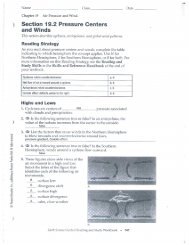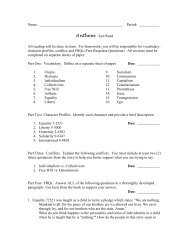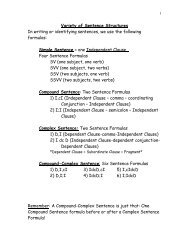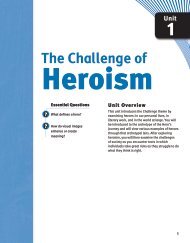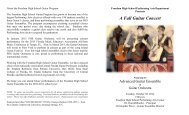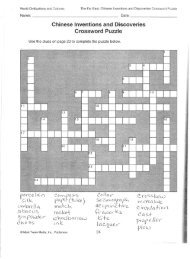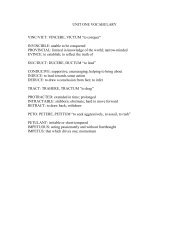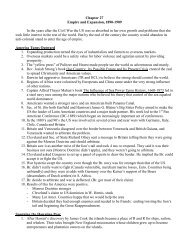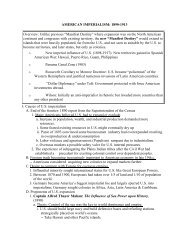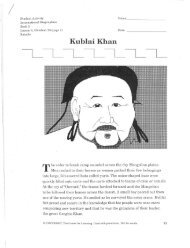Lectures #1-4 - OCPS Teacher Server
Lectures #1-4 - OCPS Teacher Server
Lectures #1-4 - OCPS Teacher Server
Create successful ePaper yourself
Turn your PDF publications into a flip-book with our unique Google optimized e-Paper software.
* Remember – Images will not appear on the PPT presentation that will be<br />
posted to the course website
Lecture <strong>#1</strong>: The Beginnings<br />
Animation<br />
Translucent (Translucency)<br />
Chronophotography (Chronophotographs)<br />
Persistence of Vision<br />
Phi Phenomenon<br />
Afterimage<br />
Bullet-Time Effect<br />
When a key term is used in the written elements of a slide it will be highlighted in BLUE<br />
Not all words will appear in a written form on a presentation slide or they will be<br />
highlighted in GOLD if they are a main point or idea
Animation (animation):<br />
1. The act, process, or result of imparting life, interest, spirit,<br />
motion, or activity.<br />
2. The quality or condition of being alive, active, spirited,<br />
or vigorous.<br />
3. A. The art or process of preparing animated cartoons.<br />
B. An animated cartoon.
Caves at Altamira – Spain<br />
Burnt City – Iran
Zoetrope<br />
180 AD (1834)<br />
• Earliest version said to have been created by Chinese<br />
inventor Ting Huan<br />
• Made from translucent paper hung over the device<br />
or a lamp<br />
• As the device spun the images would appear to move<br />
• Modern zoetrope was created by William George Horner<br />
(1834)<br />
• A cylinder with vertical slits containing a series of<br />
pictures affixed to the inside of the cylinder opposite<br />
the slits<br />
• As it spun, the viewer could look through the slits and<br />
see the images move<br />
Magic Lantern<br />
Estimated around 16 th Century (Late 1800s)<br />
• Translucent oil paintings and a single lamp<br />
• When put together in a dark room, the light would shine<br />
through the painting and project an image onto the wall<br />
• Predecessor of the modern day projector<br />
• Mechanical elements attached to the device to project limited<br />
movement on the wall
Thaumatrope<br />
(1824)<br />
• Originally designed as a simple children’s toy<br />
• A small circular disk with two different pictures (one<br />
on each side) with a string attached to either side<br />
• When the string is twisted, the two images appear to<br />
combine into one<br />
• Phi Phenomenon<br />
• Optical Illusion of perceiving continuous motion<br />
between separate objects viewed rapidly in succession<br />
Phenakistoscope<br />
(1831)<br />
• Predecessor of the modern zoetrope<br />
• Invented simultaneously by Joseph Plateau<br />
and Simon von Stampfer<br />
• Large disc containing slits and a series of<br />
images lining the outside edge<br />
• When facing a mirror, the disc is mounted<br />
and spun<br />
• The viewer can look through the slits to see<br />
the movement of the images
Flip Book<br />
(1868)<br />
• Patented by John Barnes<br />
Linnet<br />
• A set of sequential pictures<br />
flipped at a high side creates<br />
the illusion of movement<br />
Mutoscope<br />
(1894)<br />
• A flip book in a box with a<br />
crank handle to flip the pages<br />
Praxinoscope<br />
(1877)<br />
• Invented by Charles-Emile Reynaud<br />
• Sophisticated version of the zoetrope<br />
• A strip of images is placed on the<br />
inside of a spinning cylinder<br />
• Viewed in a series of small<br />
mirrors around the inside of<br />
the cylinder<br />
• Clearer image and better quality<br />
• Large version called Theatre Optique
Muybridge & Chronophotography
Lecture #2: The Era of Experimentation<br />
• Vignettes<br />
• Pantomime<br />
• Stop motion (stop frame)<br />
• Puppet Animation<br />
• Direct Film (Drawn-on Film / Cameraless Animation)<br />
• Cel Animation<br />
• Celluloid<br />
• Peg / Peg Board<br />
• Rotoscoping<br />
• Cutout Animation<br />
• Multiplane Camera<br />
• Avant-Garde<br />
• Abstract Animation<br />
• Fade In/Out<br />
• Dissolve<br />
• Silhouette<br />
• Movieola<br />
• Genre<br />
• Doubles<br />
• Live Action<br />
• Vaudeville<br />
• Pan (Panning)<br />
When a key term is used in the written elements of a slide it will be highlighted in BLUE<br />
Not all words will appear in a written form on a presentation slide or they will be<br />
highlighted in GOLD if they are a main point or idea
• French Magician and owner of the<br />
Theatre Robert Houdin<br />
• Inspired by the Lumiere Brothers and<br />
their Cinematographe in 1895<br />
• Applied his magician’s art and<br />
showmanship to his “trick films”<br />
• Stop-frame Animation<br />
• Discovered when the camera jammed<br />
and had to be restarted you could<br />
stop the film and move or substitute<br />
objects before continuing the shot<br />
• Made some of the first true narrative<br />
films and pioneered the genres of Sci-Fi,<br />
Fantasy and Horror<br />
• Pioneered techniques such as fade in/out<br />
and dissolves<br />
• Produced crude animations of dancing<br />
letters<br />
• Le voyage dans la lune (1902)<br />
(A Trip to the Moon)
• Humorous Phases of Funny Faces (1906)<br />
• Similar concept to the vaudeville acts<br />
called “chalk takes” or “lightning sketches”<br />
• Letters, words, and faces come to life on a chalkboard<br />
• The Haunted Hotel (1907)<br />
• Live-Action movie where a hotel comes to life using<br />
stop motion animation<br />
• Fantasmagorie (1908)<br />
• Over 700 drawings shot in doubles<br />
• Comic vignettes are played in pantomime for<br />
approximately 2 minutes<br />
• Drawn in white against a black background<br />
• Settings materialize and change by metamorphosis<br />
evolving from one to the next in a continuous flow<br />
Another notable “animator”: Segundo de Chomon (Spain)<br />
• El Hotel Electrico (The Electric Hotel) 1905
• Colonel Heeza Liar in Africa (1914)<br />
• First cartoon to be made as part of a series<br />
• Innovations in Animation<br />
• Pioneered the breakdown of labor into different roles<br />
• Made propaganda films for the government during WWI<br />
• Created background elements on translucent paper leading to the<br />
proposed patent for the Celluloid Sheet (Cels)<br />
• Created graytones instead of just black and white<br />
• The Debut of Thomas the Cat (1920)<br />
• Earliest recorded instance of a traditional drawn animation film in color<br />
• Patented a process of producing the animated characters onto<br />
a cel or layers of cels keeping the unmoving parts of the drawing<br />
on a separate level<br />
• Bobby Bumps (1914)<br />
• Series of sophisticated shorts with developed stories<br />
• Gray-toned backgrounds and black and white lined characters<br />
• Joined forces with JR Bray to created Bray-Hurd Patent Trust<br />
• Charged fees for anyone using the cel animation processes
“Father of Stop Motion”<br />
• Russian scientist and entomologist<br />
• Started out making educational films for a museum<br />
• Most of his early work featured insects as its stars<br />
• Some of his most notable works include:<br />
• Prekrasnaya Lyukanida (1910)<br />
The Beautiful Leukanida<br />
• Mest Kinematograficheskogo Operatora (1912)<br />
The Cameraman’s Revenge<br />
• The Night Before Christmas (1913)<br />
• Moved onto include puppet animation<br />
• Feitche (The Mascot, 1934)<br />
• Le Roman de Renard (The Tale of the Fox, 1930)<br />
• El Apostol (The Apostle 1917)<br />
• No surviving copies<br />
• Reportedly the first feature length animated film
• Originally a newspaper cartoonist<br />
• Superb draftsman with the imagination of a master storyteller<br />
• Perspective and anatomical detail are priorities in his works<br />
• Little Nemo in Slumberland / Dreams of a Rarebit Fiend<br />
• First film effort: Little Nemo with J. Stuart Blackton (1911)<br />
• Worked for 4 years completing 4,000 drawings<br />
• Hand-colored the 35mm frames<br />
• No storyline to the film – Characters show a continuous<br />
parade of movement, metamorphosis, and exaggeration<br />
• The Story of a Mosquito (1912)<br />
• Tells the story of a mosquito’s encounter with a drunken man<br />
• Took only a year to complete<br />
• Gertie the Dinosaur (1914)<br />
• 10,000 drawings in the one reel film<br />
• Inked on rice paper and mounted to cardboard<br />
• For the first time an artist breathed life into an inanimate<br />
character and gave her a personality<br />
• The Centaurs and The Sinking of the Lusitania<br />
• With the creation of Gertie, an industry was<br />
born – an industry that McCay wanted not<br />
part of<br />
• Drifted away from animation in the early<br />
1920’s to continue his work with newspapers<br />
and to work on films at his own pace
Lecture #2: The Era of Experimentation<br />
• Vignettes<br />
• Pantomime<br />
• Stop motion (stop frame)<br />
• Puppet Animation<br />
• Direct Film (Drawn-on Film / Cameraless Animation)<br />
• Cel Animation<br />
• Celluloid<br />
• Peg / Peg Board<br />
• Rotoscoping<br />
• Cutout Animation<br />
• Multiplane Camera<br />
• Avant-Garde<br />
• Abstract Animation<br />
• Fade In/Out<br />
• Dissolve<br />
• Silhouette<br />
• Movieola<br />
• Genre<br />
• Doubles<br />
• Live Action<br />
• Vaudeville<br />
• Pan (Panning)<br />
When a key term is used in the written elements of a slide it will be highlighted in BLUE<br />
Not all words will appear in a written form on a presentation slide or they will be<br />
highlighted in GOLD if they are a main point or idea
Innovations<br />
• Peg Bar (Barre, 1914)<br />
• Used for Drawing Registration<br />
• Paper was uniformly perforated along either the bottom or the top an then held in<br />
place by a bar fixed to the drawing board<br />
• Slash System (Barre, 1914)<br />
• A method for separating the still background and the animated foreground by cutting<br />
(or slashing) thepaper between the two areas<br />
• Panning backgrounds (Nolan, 1914)<br />
• Long background drawings that are moved along frame by frame under the<br />
camera to give the illusion of the camera tracking along a path with a character<br />
• Together established the world’s first commercial animation studio in the Bronx<br />
Animations<br />
• The Animated Grouch Chasers (1915)<br />
• Mutt & Jeff (1916)
• Young cartoonist working as an art editor of Popular Science Monthly<br />
• Rotoscope (1916)<br />
• Used his interest in science to create a machine that could capture movement<br />
and make animated films<br />
• The device projected film frame-by-frame onto a light table<br />
where an artist could trace the movements of figures.<br />
• Fleischer Brothers helped Max by working together to make<br />
the actual machine as well as pose for the first animation<br />
created with the technology Koko the Clown<br />
• Fleischer was soon hired by Bray to make a<br />
series entitled Out of the Inkwell<br />
• In the series, Koko the Clown interacts<br />
with the animator and the<br />
“real” world around him<br />
The Fleischer Brothers will<br />
continue to make animations<br />
over the next several decades
• Early animation experience consisted of studying Charlie<br />
Chaplin’s performances and animating Chaplin cartoons<br />
• Felix the Cat (1919)<br />
• Largest cartoon star of the 1920s<br />
• Created and Animated by Otto Messmer / Produced<br />
by Pat Sullivan<br />
• Bold and simple style that had a strong design based on<br />
geometric shapes and a strong silhouette<br />
• No technology innovations necessarily went into Felix, but his acting,<br />
performance, and ability to connect to the audience led to his cult status<br />
• Kansas City Cartoonist<br />
• Laugh-O-Gram Films (1922)<br />
• Shorts demonstrated a great sense of storytelling and<br />
comic timing<br />
• They were moderately successful, but filed for bankruptcy<br />
• Alice in Cartoonland (1923)<br />
• Completed the pilot film prior to filing for bankruptcy<br />
• Picked up by a distributor, Margaret J. Winkler<br />
• A series grew entitled the Alice Comedies and combined live action/animation
Filmstudie (1926)<br />
Ballet Mecanique (1924)<br />
Lichtspiel Opus 1 (1921)<br />
Symphonie Diagonale (1924)
• The Lost World (1925)<br />
• Based on a short story by Arthur Conan Doyle<br />
• First feature film to include stop frame animation<br />
combining “lifelike dinosaurs and human actors<br />
• Inspiration and basis for King Kong<br />
• Die Abenteuer des Prizen Achmed (1925 – 26)<br />
(The Adventures of Prince Achmed)<br />
• Earliest surviving animated feature film<br />
• Adaptation from Andrew Lang’s<br />
The Blue Fairy Book<br />
• Translated Middle Eastern and Asian<br />
fairytales and folklore into English for the first time<br />
• Cutout silhouette style resembles traditional Asian<br />
shadow puppets<br />
• First film to use a form of multiplane camera
Lecture #3: The Golden Age of Cartoons<br />
Synchronization<br />
Short*<br />
Feature Length*<br />
Pinscreen<br />
Anthology<br />
Lip Sync<br />
Monochromatic*<br />
Pencil Test<br />
Limited Animation<br />
Animatic<br />
Armature<br />
Theme<br />
Paint and Trace (Ink & Paint)<br />
Dynamation*<br />
*Defined on PPT slide or lecture only<br />
When a key term is used in the written elements of a slide it will be highlighted in BLUE<br />
Not all words will appear in a written form on a presentation slide or they will be<br />
highlighted in GOLD if they are a main point or idea
Steamboat Willie (1928)<br />
• Mickey Mouse pilots a boat while having difficulties<br />
with Pegleg Pete<br />
• Large investment in sound equipment – Powers<br />
Cinephone to create sound synchronization<br />
• Mickey did appear in a couple earlier cartoons<br />
that were not distributed – once Steamboat Willie was<br />
released, sound was added and they were released as follow ups<br />
Minnie Mouse - Steamboat Willie (1928)<br />
Pluto - The Chain Gang (1930)<br />
Goofy (Dippy Dawg) - Mickey’s Revue (1932)<br />
Donald Duck - The Wise Little Hen (1934)<br />
Daisy Duck (Donna) – Don Donald (1937)<br />
(Daisy appears in Mr. Duck Steps Out)<br />
Golden Age of<br />
Cartoons Begins
• A series of 75 musical shorts starred cheerful and optimistic<br />
characters that gave audiences a lift during the Great Depression<br />
• Some notable cartoons of the series are:<br />
• Skeleton Dance (1929)<br />
• First cartoon of the series<br />
• Unusual cartoon because it was specifically built<br />
around the music of Carl Stalling and it has no main<br />
character or star<br />
• Three Little Pigs (1933)<br />
• Most successful of the Silly Symphonies<br />
• One of the most successful short films of all time<br />
• Characters, although similar, have distinct personalities<br />
• Followed up by 3 somewhat unsuccessful sequels –<br />
led to the belief that sequels do not help a studio move forward<br />
• The Old Mill (1936)<br />
• Marks the moment when animation moved into the world of<br />
realism
• Walt Disney’s first feature length film<br />
• Nicknamed Disney’s Folly<br />
• Went 6 times over original budget - $1.7 million<br />
• Highest grossing film of the year<br />
• 750 – 1000 artists employed<br />
• Film contains the full emotional spectrum from<br />
light to dark / good to evil / Happy to Grumpy<br />
• Film’s colors were muted due to concerns that<br />
audiences would not be able to sit through the<br />
usual bright colors for an extended time<br />
• Paint and trace department women<br />
actually added their own make up to Snow<br />
White to bring color to her cheeks<br />
• Seven Dwarfs were all essentially the same<br />
character with uniquely different personalities<br />
In less than a decade<br />
Disney went from monochromatic rhythmic rubberyness<br />
to a realistically animated feature in full color
From 1931 – 1939 Walt Disney wins ALL of the Oscars for<br />
Animated Short Film (Short Subject – Cartoons)<br />
1939<br />
Disney receives an<br />
Special Honorary<br />
Oscar for his<br />
achievements with<br />
Snow White and<br />
The Seven Dwarves
• Unlike Disney’s short films that were concerned with childlike situations and<br />
problems, Fleischer cartoons like those of Betty Boop and Popeye were grounded<br />
in a much more adult kind of world.<br />
• Production Code (Hays Code) – 1934<br />
• Controls the content of movies, which forced many changes<br />
in the tone of the Betty Boop cartoons<br />
Betty Boop<br />
• Dizzy Dishes (1930) – First appearance of “Betty Boop”<br />
• Stopping the Show (1932) – First “Betty Boop Cartoon”<br />
• Rhythm on the Reservation (1939) – Last Betty Boop Cartoon<br />
Popeye the Sailor Man<br />
• Directed by Dave Fleischer<br />
• Olive Oyl is kidnapped by Bluto causing<br />
Popeye to eat a can of spinach and goes to<br />
save his love<br />
• Lillian Friedman was promoted to the<br />
position of animator – First woman to hold<br />
this position professionally in the States
• Curiosity of primates was high in the early 20 th century<br />
• Other films about primates had been made with little success<br />
• The character of King Kong was a series of 18 inch models<br />
made from foam, rubber, and animal skins over metal skeletons<br />
• Scenes with human actors were shot with life size models<br />
of the gorilla’s head, hand and foot<br />
• Considered to be one of the most famous films of all time<br />
• Known for his adaptations of fairytales<br />
• Nicknamed the “Soviet Disney”<br />
• Started out as a mechanical engineer - invented an adding machine<br />
• Joined Moscow’s Mosfilms as a puppet maker in 1927<br />
• Made several short films starring a character named Bratsihkin<br />
• Novyy Gulliver (New Gulliver, 1935)<br />
• First Russian animated feature film<br />
• Cast over 3,000 puppets that utilized lip syncing<br />
• Zolotoy klyuchik (The Golden Key, 1939)<br />
• Kamennyy tsvetok (Stone Flower, 1946)<br />
• First Russian film in color
• Left Russia after the October Revolution of 1917<br />
• Worked as a set designer and book illustrator<br />
• Pinscreen Animation<br />
• A device contained hundreds of pins that slid in and<br />
out of a grid<br />
• Created an infinitely pliable surface shape which produced relief<br />
shadow images especially when lit from the side<br />
• Une nuit sur le mont chauve (Night on Bald Mountain, 1933)<br />
• Took 18 months to make<br />
• Based on the Modest Mussorgsky’s short symphony<br />
• Film avoids cute Halloween-esque images – uses obscure unsettling images<br />
• Dream-like shadowed smeared quality
• Established by Albert, Harry, Sam, and Jack Warner in 1923<br />
• Producer Leon Schlesinger established an animation studio on their lot in 1927<br />
• Hugh Harman and Rudolf Ising created the Looney Tunes series in 1930 and<br />
Merrie Melodies in 1931<br />
• First character named Bosko – Eventually taken to MGM<br />
• Animators hired after Harman and Ising left:<br />
• Chuck Jones / Bob Clampett / Robert Cannon / Tex Avery<br />
• Schlesinger moved the animators away from the main team and<br />
moved them into a cabin nicknamed Termite Terrace<br />
• Some of the characters created include:<br />
• Porky Pig / Daffy Duck / Bugs Bunny / Speedy Gonzales /<br />
Wile E. Coyote / Road Runner<br />
• Significant Cartoons of the 30’s<br />
• Porky’s Duck Hunt (1937)<br />
• Daffy Duck is introduced by Tex Avery<br />
• Daffy Duck and Egghead (1938)<br />
• Egghead would eventually become Elmer Fudd (Tex Avery)<br />
• Bob Clampett picks up Daffy then passed to multiple animators<br />
(Robert McKimson, Friz Freleng, Art Davis, & Chuck Jones)<br />
• Porky in Wackyland (1938)<br />
• Porky’s Hare Hunt (1938)<br />
• Bugs Bunny makes his debut – created by animator Ben “Bugs” Hardaway
Lecture #3: The Golden Age of Cartoons<br />
Synchronization<br />
Short*<br />
Feature Length*<br />
Pinscreen<br />
Anthology<br />
Lip Sync<br />
Monochromatic*<br />
Pencil Test<br />
Limited Animation<br />
Animatic<br />
Armature<br />
Theme<br />
Paint and Trace (Ink & Paint)<br />
Dynamation*<br />
*Defined on PPT slide or lecture only<br />
When a key term is used in the written elements of a slide it will be highlighted in BLUE<br />
Not all words will appear in a written form on a presentation slide or they will be<br />
highlighted in GOLD if they are a main point or idea
• Worked for the Bray studios working on the Farmer<br />
Al Falfa series<br />
• Established Terrytoons Studio in 1929<br />
• Studio had the lowest budgets and were the slowest to<br />
new technologies such as sound<br />
• Dinner Time (October 1928)<br />
• First “Synchronized” sound cartoon<br />
• Did not achieve the fame nor the recognition of<br />
Steamboat Willie<br />
• The Mouse of Tomorrow (1942)<br />
• First appearance of Mighty Mouse (as Super Mouse)<br />
• Popular to some extent with its preliminary cartoons –<br />
gained larger popularity after the invention of the<br />
television<br />
• Heckle & Jeckle (1946)<br />
• A pair of identical magpies who<br />
calmly outwit their foes while<br />
maintaining an aggressively<br />
mischievous streak<br />
• Considered to be the best cartoons<br />
the studio ever made
• Started at the age of 15 working at the William Hearst<br />
International Studio<br />
• Ran his own studio from 1929 – 1972<br />
• Knock Knock (1940)<br />
• First appearance of Woody Woodpecker in<br />
an Andy Panda cartoon<br />
• Woody would continue to be made until Lantz’s retirement in 1972<br />
• William Hanna and Joseph Barbera worked together at MGM<br />
• First cartoon made together was Puss gets the Boot in 1940<br />
• Starred a cat name Jasper who chases an unnamed mouse<br />
• The two would eventually become known as Tom and Jerry<br />
and be considered MGM’s most popular characters<br />
• Paramount encouraged the Fleischer Bros Studio to work with the Superman<br />
• They were able to pencil test the animation<br />
• Film Noir stylization came from the camera angles and overall design<br />
• Did not shy away from the “scary stuff ”<br />
• Fleischer Bros made 8 Superman episodes before the takeover<br />
• Studio renamed Famous Studios who created 9 more Superman episodes
• Pinocchio (1940): Financial Failure<br />
• Fantasia (1941): Financial Failure<br />
• Started out as a Silly Symphonies Short<br />
• Wanted to create the ultimate experience with the idea of<br />
using animation as a form of visual music and raising the idea<br />
of animation as a respectable art form<br />
• Dumbo (1941): Disney’s largest grossing film of the 1940s<br />
• Shortest of Disneys features<br />
• Bambi (1942): Initial Financial failure – turned a profit after<br />
its 1947 rerelease<br />
• B-Movie Type Features<br />
• “package movies” – or collections of shorter subject packaged<br />
together (also known as anthology or portmanteau films)<br />
• Saludos Amigos (1943)<br />
• Three Caballeros (1945)<br />
• Song of the South (1946)<br />
• Uncle Remus Stories by Joel Chandler Harris
• China’s animation pioneers<br />
• Uproar in the Studio (1924)<br />
• China’s first animated short<br />
• Tie Shan gong zhu (Princess Iron Fan, 1941)<br />
• China’s first animated feature film<br />
• Based on the Buddhist tale, Journey to the West<br />
• One of Japan’s animation pioneers<br />
• Worked as an animator and special effects artist<br />
• Nicknamed the “Japanese Melies”<br />
• Chikara to onna no yo no naka (1933)<br />
• First Japanese animation with sound<br />
• Chagama Ondo (The Dance of the Chagamas, 1934)<br />
• First Japanese film made entirely using cel<br />
animation<br />
• Kumo to Churippu (The Spider and the Tulip, 1943)
• Fast and Furry-ous (1949)<br />
• The chaser defeated himself through his own ineptitude<br />
• Never intended to be part of a series<br />
• The famous Beep Beep was taken from Paul Julian, a<br />
background artist, who made the sound as he carried large<br />
background around the studio<br />
• The Dover Boys At Pimento University (1942)<br />
• Jones experimented with a simplified style that would be<br />
adopted by UPA studios<br />
• Red Hot Riding Hood (1943)<br />
• Adaptation of the Red Riding Hood story<br />
• First film created after arriving at the MGM studios<br />
• Censors believed the cartoons antics were too<br />
suggestive and recommended cuts be made<br />
• Considered to be the most successful of MGM’s<br />
cartoons to date
• Established by ex-Disney animators Zack Schwartz, David Hilberman, Stephen Bosustow<br />
• Originally worked under the studio name Industrial Film and Poster Service<br />
• Founded based on the idea of simple design and limited animation<br />
• Came under suspicion for “communist leanings” due to their free-thinking ideas<br />
• However, after the war ended, they were offered a contract with Columbia Pictures<br />
• Robin Hoodlum (1948) & The Magic Fluke (1949)<br />
• Featured characters Fox and Crow<br />
• After the success, UPA was given permission to make their own characters<br />
• Mr. Magoo<br />
• A grumpy old man who refuses to admit his chronic near-sightedness<br />
• Created by John Hubley and based on his uncle and W.C. Fields<br />
• Ragtime Bear (1949)<br />
• Magoo’s first cartoon<br />
• Magoo mistakes a bear for his banjo playing nephew<br />
• After the first cartoon, Hubey stepped away and the<br />
series was taken over by Pete Burness
During World War II many studios produced wartime propaganda<br />
films to support their studios during the rough times<br />
Walt Disney Studios<br />
• Commissioned to make 32 propaganda, training, and<br />
educational shorts between 1941 – 1945<br />
• Best Known short was Der Fuehrer’s Face (1943)<br />
• Won the Oscar for Best Animated Short<br />
• Victory Through Air Power (1943)<br />
• Feature Length PR push for the need to build<br />
more war planes<br />
United Productions of America (UPA)<br />
• Hell Bent for Election (1944)<br />
• Depicts a fast modern train, representing Roosevelt<br />
racing with a broken-down old steam train,<br />
representing Repubican candidate, Thomas E. Dewey<br />
• Flat Hatting (1945)<br />
• Instructional film for the Navy<br />
• The Brotherhood of Man (1945)<br />
• Addresses racial integration
Lecture #3: The Golden Age of Cartoons<br />
Synchronization<br />
Short*<br />
Feature Length*<br />
Pinscreen<br />
Anthology<br />
Lip Sync<br />
Monochromatic*<br />
Pencil Test<br />
Limited Animation<br />
Animatic<br />
Armature<br />
Theme<br />
Paint and Trace (Ink & Paint)<br />
Dynamation*<br />
*Defined on PPT slide or lecture only<br />
When a key term is used in the written elements of a slide it will be highlighted in BLUE<br />
Not all words will appear in a written form on a presentation slide or they will be<br />
highlighted in GOLD if they are a main point or idea
• Cinderella (1950) – Financial Success<br />
• Alice in Wonderland (1951) – Poorly Received<br />
• Peter Pan (1953)<br />
• These three films lacked chills or evil bad guys causing the stories to be blander<br />
than the films of the 40s<br />
• Brilliantly crafted films that lacked innovation, inspiration, or pioneering spirit<br />
• Walt Disney switched his attentions to theme parks and television docu-films<br />
• Animations were left in the hands of the Nine Old Men<br />
• Lady and the Tramp (1955) – Financial Success<br />
• First Disney feature filmed in widescreen
• Gerald McBoing Boing (1951)<br />
• Adapted from a story written by Dr. Seuss<br />
• Story involves a young boy who can only make<br />
sound effects as he speaks<br />
• Used only muted flat colors and uses only<br />
elemental lines<br />
• Won the Oscar for Animated Short in 1951<br />
• Other shorts by UPA include:<br />
• The Oompahs (1952)<br />
• Georgie and the Dragon (1951)<br />
• Madeline (1952)<br />
• Christopher Crumpet (1953)<br />
• A Unicorn in the Garden (1953)<br />
• A Tell Tale Heart (1953)<br />
• A straight ahead horror cartoon<br />
• John Hubley also directed several pieces that tended<br />
to be more adult oriented:<br />
• Rooty Toot Toot (1951)<br />
• Murder story from different perspectives<br />
• The Fourposter (1952)<br />
• Created the animated segments for a live action film
• Created by Alex Anderson and producer Jay Ward<br />
• First cartoon made specifically for television<br />
• Limited Animation Style (barely animated at all)<br />
• Feels like you are watching an animatic<br />
• Strengths are in the zany writing and the comic-strip<br />
style stills of the characters<br />
• 195 5-minute episodes were created / 250 more were made<br />
• Directed by Chuck Jones<br />
• Demonstrates that the animator can do absolutely<br />
anything absolutely easily<br />
• Proved that its not about reproducing reality, its about<br />
altering reality and looking at it from a different perspective<br />
• Trying to show that Daffy as a character transcends a<br />
cartoon setting and possibly has a soul<br />
• Listed as 2 nd on the list of 50 Greatest Cartoons
• Inspired by the work of Willis O’Brien<br />
• Met O’Brien in 1938 who inspired him to take<br />
art, anatomy, and film classes<br />
• Worked with O’Brien on Mighty Joe Young (1949)<br />
• Worked briefly for George Pal on his Puppetoons<br />
• After serving in WWII – created a a series of nursery<br />
rhymes entitled Mother Goose Stories (1946)<br />
using armatured models<br />
• The Beast from 20,000 Fathoms (1953)<br />
• Directed by Eugene Lourie<br />
• Ray was responsible for the stop motion<br />
animations and modeling<br />
• First film to use the dynamation technique<br />
where a split screen is used to insert the model<br />
animation into live action<br />
• Earned $5 million on a $200,000<br />
budget<br />
• The film effects helped to<br />
inspire a genre of giant<br />
monster movies – including<br />
Godzilla
• Handling Ships (1945)<br />
• First British feature film released as a training film for t<br />
• he Navy<br />
• Animal Farm (1954)<br />
• First British feature film to get a general release<br />
• Based on George Orwell’s novel<br />
• Increased realism helps audiences focus on the story<br />
• Dark colors are used to reflect the somber theme<br />
• Happy ending – different from the ending of the novel<br />
• In both the UK and the US, it was described as one of<br />
the greatest animated feature<br />
• First animated feature dared to tell a grown-up story<br />
aimed at an adult audience
Lecture #4: The Television Age<br />
Character Animation<br />
Effects Animation (Special Effects / EFX)<br />
Anime<br />
Xerox<br />
Morph (Morphing)<br />
Anthropomorphization<br />
Improv (Ad Lib)<br />
Rendered<br />
Establishing Shot<br />
Lo-Fi Animation<br />
Dubbing<br />
When a key term is used in the written elements of a slide it will be highlighted in BLUE<br />
Not all words will appear in a written form on a presentation slide or they will be<br />
highlighted in GOLD if they are a main point or idea
• 1001 Arabian Nights (1959) - Peter Burness / Jack Kinney<br />
• Visually well made with a slow moving story<br />
• Gay Purr-ee (1962) - Abe Levitow<br />
• Never generated enough revenue – UPA closed in 1964<br />
• Friz Freleng & David DePatie: DePatie-Freleng Enterprises in 1964<br />
• Commissioned to create the opening credits for<br />
The Pink Panther<br />
• The Pink Phink (1964)<br />
• The success of the pink panther took off and led to<br />
other series: The Inspector & The Ant and the Aardvark<br />
• The Dot and the Line (1965)<br />
• Created during his time at MGM<br />
• The Phantom Tollbooth (1970)<br />
• Directed by Chuck Jones & Abe Levitow<br />
• MGM’s animation department was closed soon after this<br />
production and did not fund another animated film until 1982
• The Adventures of an * (1957)<br />
• Used double exposures to produce<br />
overlaid images and filming the layers<br />
half-exposed to make them semi-transparent<br />
• Moonbird (1959)<br />
• Funded by the Guggenheim Museum<br />
• Based on improvised play of their children<br />
• Soundtrack consisted of improvised unscripted play talk<br />
• Colored the image with wax crayons and black ink<br />
• Eggs (1970)<br />
• Loose spontaneous visual narrative style – grittier drawings<br />
• A more serious heavy handed topic of overpopulation<br />
• Mothlight (1963)<br />
• Direct Cinema – No camera was used<br />
• Found objects of insects wings, beetles legs, and<br />
leaves were glued between two strips of film<br />
• Scratched, painted, and pressed natural objects directly<br />
onto the film stock
Sleeping Beauty (1959)<br />
• Released in widescreen & stereophonic sound<br />
101 Dalmations (1961)<br />
• 1 st Disney film to use Xerox process<br />
The Sword in the Stone (1963)<br />
Mary Poppins (1964)<br />
The Jungle Book (1967)<br />
• 1 st time character movements and acting were based on the<br />
personalities and filmed movements of the voice actors<br />
• Encouraged Voice Actor Improv (Ad Lib)<br />
The Aristocats (1970)<br />
• Last film to be greenlit by Disney<br />
Robin Hood (1973)<br />
Many Adventures of Winnie the Pooh (1977) (Anthology Style)<br />
The Rescuers (1977)<br />
• Opening weekend animation box office grossing record<br />
The Fox and the Hound (1981)<br />
Who Framed Roger Rabbit (1988)
• Ex-Disney Animators: Don Bluth, Gary<br />
Goldman, & John Pomeroy established<br />
Don Bluth Productions (1979)<br />
• Banjo the Woodpile Cat (1979)<br />
• Sold directly to television<br />
• Secret of NIMH (1982)<br />
• Rejected by Disney for being too dark<br />
• Techniques used: color Xerography / split<br />
exposure / diffusion to create shadows,<br />
translucency and reflections<br />
• An American Tail (1986)<br />
• Produced by Steven Speilberg<br />
• Highest grossing animated film until 1988<br />
• The Land Before Time (1988)<br />
• All Dogs Go to Heaven (1989)
• A Charlie Brown Christmas (1965)<br />
• Directed by Bill Melendez<br />
• Funded by the Coca-Cola Company<br />
• How the Grinch Stole Christmas (1966)<br />
• Directed by Chuck Jones<br />
• Rankin/Bass Stop Motion TV Specials<br />
• Rudolph the Red Nosed Reindeer (1964)<br />
• Santa Claus is Coming to Town (1970)<br />
• The Year Without a Santa Claus (1974)<br />
• The Snowman (1982) - UK<br />
• Directed by Dianne Jackson<br />
• Silent except for the score<br />
• Hand-rendered in pastel colors for the<br />
characters and the background<br />
• A Christmas Carol (1971)<br />
• Directed by Richard Williams<br />
• Originally created as a made-for<br />
tv short – Oscar winner<br />
• Inventive traveling<br />
establishing shots<br />
• Mr Magoo’s Christmas Carol (1962)
• MGM’s animation unit closed in 1957 –<br />
Hanna & Barbera created their own studio<br />
• The Ruff & Reddy Show (1957)<br />
• The Huckleberry Hound Show (1958)<br />
• Show had a minimalistic quality<br />
similar to the limited style of UPA<br />
• Flintstones (1960-1966)<br />
• First animated sitcom and the only<br />
cartoon to successfully fill a primetime<br />
slot until The Simpsons<br />
• Animation was cheap to produce yet<br />
managed to maintain a funny and<br />
memorable watch-ability due to the writing,<br />
characters, and catchy tunes
Lecture #4: The Television Age<br />
Character Animation<br />
Effects Animation (Special Effects / EFX)<br />
Anime<br />
Xerox<br />
Morph (Morphing)<br />
Anthropomorphization<br />
Improv (Ad Lib)<br />
Rendered<br />
Establishing Shot<br />
Lo-Fi Animation<br />
Dubbing<br />
When a key term is used in the written elements of a slide it will be highlighted in BLUE<br />
Not all words will appear in a written form on a presentation slide or they will be<br />
highlighted in GOLD if they are a main point or idea
• Storytime<br />
• Lo-Fi Animation Style using cutout photos,<br />
Victorian imagery, surreal machines, and<br />
bizarre illustrations<br />
• Monty Python’s Flying Circus<br />
• Provided integral transitions throughout the<br />
show as well as in the feature films Monty<br />
Python and the Holy Grail (1975) and<br />
Life of Brian (1979)<br />
• John Hubley originally hired as director, but left after<br />
completing the opening scene<br />
• Martin Rosen stepped in as director<br />
• Originally marketed as a family friendly film<br />
• Considered to have one of the goriest scene in<br />
an animated film<br />
• Stayed away from anthropomorphic characters and<br />
stuck to realistic and nonidealized characters
• The Yellow Submarine (1968)<br />
• Directed by George Dunning<br />
• Each song was animated in a different style<br />
• Considered on of the great rock movies<br />
• Pink Floyd’s The Wall (1982)<br />
• Designed and Directed by satirical cartoonist<br />
Gerald Scarfe<br />
• Wild and aggressive ink splattered designs<br />
• Explores the feelings of isolation and alienation<br />
• The “magic” of animation comes from the morphing<br />
of objects from one thing to another<br />
• Doves to vultures to war planes<br />
• A-ha: Take on Me (1985)<br />
• Directed by Steven Barron / Animated by Michael<br />
Patterson<br />
• Features the singer of the band coming alive from a<br />
comic’s page in the form of a rotoscoped animated<br />
character
• Taiji Yabushita – Hakuja Den (The Tale of the White Serpent, 1958)<br />
• First full length animated feature in color<br />
• Based on special effects and spectacle rather than character animation<br />
• Osamu Tezuka – Astro Boy (1963)<br />
• Created the manga as well as the cartoon<br />
• Credited as the series that introduced the anime style to the world<br />
• Remade in color in the 1980s and 2003 – CG film in 2009<br />
• Toei Doga – Cyborg 009<br />
• Kaitei Shonen Marin – Marine Boy<br />
• Originally releases as Dolphin Prince in 1967 and cancelled almost immediately<br />
• Rereleased as Marine Boy (78 episodes)<br />
• 1 st successful anime in the UK<br />
• Hiroshi Sasagawa – MACH GO GO GO (Speed Racer, 1967)<br />
• Sazae-san (Fuji Television) 1969<br />
• Based on Machiko Hasewaga manga featured in newspapers from<br />
1946 – 1974<br />
• World’s longest running animation series<br />
• Renzo & Sayoko Kinoshita<br />
• Helped to establish the Hiroshima International Film Festival<br />
• Nippon Seizou (Made in Japan, 1972)<br />
• Pica-don (1972)<br />
• One of the most harrowing and disturbing animation shorts of<br />
all time
• Akira (1988)<br />
• Combination of digital and cel animation<br />
• Credited for breaking open the market for<br />
anime in the West<br />
• Most significant Japanese adult-aimed animation<br />
• The first Japanese film to use the standard western<br />
technique of recording the sound before the pictures<br />
• Usual practice in Japan was to dub the sound over<br />
the picture<br />
• Other projects include:<br />
• Rojin Z (Old man Z, 1991) – animator<br />
• Warudo apatomento hora<br />
(World Apartment Horror, 1991) – writer<br />
• Memories (1995) – director<br />
• Metropolis (2001) – producer<br />
• Steamboy (2004) – director
• Taiyo No Oji: Horus No Daiboken<br />
(Prince of the Sun: The Adventure of Horus, 1968)<br />
• Takahata’s debut feature<br />
• Arupusu no shojo Haiji (Heidi, 1974)<br />
• Television series adapted from the book Heidi<br />
• Dubbed in 19 different languages<br />
• Rupan Sansei: Kariosutoro no shiro<br />
(Castle of Cagliostro, 1979)<br />
• Miyazaki directorial debut<br />
• STUDIO GHIBLI ESTABLISHED IN 1985<br />
• Primarily focused on traditionally drawn<br />
animation<br />
Studio Ghibli
• Followed UPA’s style of limited animation<br />
• The Duga Film studio<br />
• Produced Croatia’s first animated film The Big<br />
Meeting in 1951<br />
• Former members of Duga Film formed Zagreb<br />
Film in 1956<br />
• Aimed to produce experimental and creative<br />
animation<br />
• Samac (Alone, 1958)<br />
• Dialog-free short that initiated several<br />
existential films that question and comment<br />
on the human condition<br />
• Surogat (Ersatz, 1961)<br />
• Oscar for animated short film went out of<br />
the US for the first time<br />
• Professor Balthazar (1967)<br />
• 52 episodes featured an eccentric old inventor<br />
• The Masque of the Red Death (1969)<br />
• Considered one of the greatest horror shorts<br />
• Satiemania (1978)
• Flaklypa Grand Prix (The Pinchcliffe Grand Pix, 1975)<br />
• Directed by Ivo Caprino<br />
• Created an early form of animatronics in order to<br />
manipulated his puppets in real time<br />
• Shown daily in certain theaters for 28 years<br />
• Dot and the Kangaroo (1977)<br />
• Directed by Yoram Gross<br />
• Laid characters over photographic backgrounds<br />
• Led to 7 sequels<br />
• La flute a six schtroumpfs (The Smurfs<br />
and the Magic Flute, 1976)<br />
• Originally created by cartoonist<br />
Peyo in 1958<br />
• Hanna-Barbera began producing<br />
the US Smurfs series in 1981<br />
• The Smurfs and the Magic Flute<br />
was released in the US in 1983



